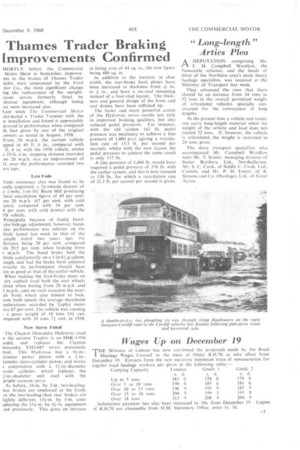Thames Trader Braking Improvements Confirmed
Page 39

If you've noticed an error in this article please click here to report it so we can fix it.
HORTLY before the Commercial Motor Show in September, improvelilts to the brakes of Thames Trader licks were announced by the Ford ptor Co., the most significant change ing the replacement of the uprightzuum servos formerly fitted by dr ovac equipment, although lining as were increased also.
Last week The Commercial Motor ike-tested a Trader 7-tonner with the w installation and found it appreciably proved in performance when compared th that given by one of the original miners as tested in August, 1958.
From 30 m.p.h. the current vehicle ipped in 49 ft. 6 in., compared with ft. 6 in. with the 1958 vehicle, whilst e 25-ft. 6-in, stopping distance recorded im 20 m.p.h. was an improvement of ft. over the performance recorded two ars ago.
Less Fade Fade resistance also was found to be eatly improved, a 21-minute descent of c 1-in-101 Bison Hill producing final retardation figure of 49 per cent. om 20 m.p.h. (67 per cent. with cold urns), compared with 34 per cent. 8 per cent. with cold drums) with the l58 vehicle.
Principally because of faulty handake-linkage adjustment, however, handake performance was inferior on the hide tested last week to that of the .ample tested two years ago, the fference being 20 per cent, compared ith 29.5 per cent, when braking from 1 m.p.h. The hand brake held the ifiele satisfactorily on a 1-in-61 gradient, Lough, and had the brake been adjusted wrectly its performance should have ;en as good as that of the earlier vehicle. When making the foot-brake stops on dry asphalt road both the rear wheels 'eked when testing from 20 m.p.h. and ) m.p.h., and on each occasion the nearde front wheel also tended to lock. rom both speeds the average maximum !celerations recorded by Tapley meter ere 67 percent. The vehicle was running : a gross weight of 10 tons 141 cwt. wripared with 10 tons 71 cwt. in 1958.
New Servo Fitted
The Clayton Dewandre Hydrovac used n the current Traders is an 1-1SR-5-950 iodel, and replaces the Clayton tewandre VH3/687 servo previously tied. This Hydrovac has a 91-in.iameter power piston with a 7c-in.iameter slave-cylinder piston, and works t conjunction with a 11-in.-diameter taster cylinder, which replaces the 1-in.-diameter unit used with the pright vacuum servo.
As before, 16-in. by 3-in. two-leadinghoe brakes arc employed at the front, ut the two-leading-shoe rear brakes are lightly different, 153.-in. by 5-in, units eplacing the 153.-in. by 41-in. equipment sed previously. This gives an increase in lining area of 44 sq. in., the new figure being 480 sq. in.
In addition to the increase in shoe width, the rear-brake back plates have been increased in thickness from ic in.
to in., and have a six-stud mounting instead of a four-stud layout. The thickness and general design of the front and rear drums have been stiffened up.
The faster and more powerful action of the Hydrovac servo results not only in improved braking qualities, but also reduced pedal pressures. For instance, with the old system 142 lb. pedal pressure was necessary to achieve a line pressure of 1,000 p.s.i. (giving a retardation rate of 15.3 ft. per second per second), whilst with the new layout the pedal pressure to achieve the same result is only 117 lb.
A line pressure of 1,400 lb. would have required a pedal pressure of 370 lb. with the earlier system, and this is now reduced to 150 lb., for which a retardation rate of 21.5 ft. per second per second is given.
























































































































